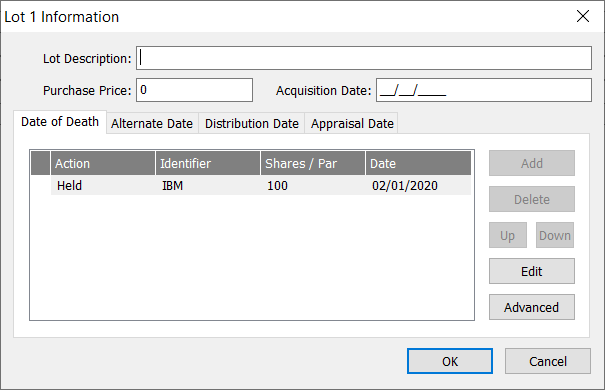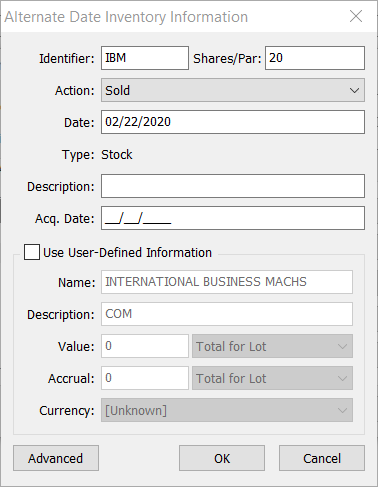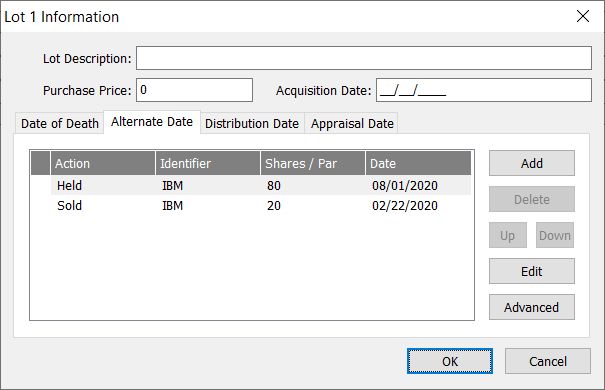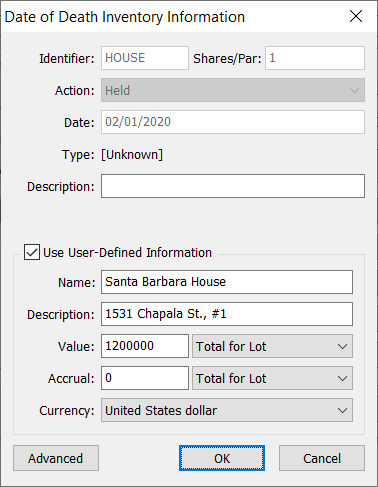The introductory EstateVal Tutorial taught you about the main features of the software, and that’s how you’ll use it almost all the time. But there is still a lot more functionality available, and it gives you a lot more power.
Other Reports
EstateVal’s two main reports are the Date of Death and the Alternate Date, but it also offers two others: the Distribution Date and Appraisal Date.
The Distribution Date report is for doing quick evaluations for fund or trust distributions. It doesn’t include dividends or accruals, but has high/low prices to determine the value of the portfolio. It’s less expensive to run than Date of Deaths or Alternate Dates because it doesn’t include as much detail.
An Appraisal Date report is for for doing regular appraisals of an estate’s value. Like the Distribution Date report, it doesn’t include dividends or accruals, but uses closing prices instead of high/lows. It’s also cheaper than the Date of Death and Alternate Date reports, and is designed to be run for different dates regularly, to track the portfolio’s recent worth.
To run a Distribution or Appraisal Date report, you’ll first need to enter the date the holdings are to be evaluated, by clicking the Edit Dates button to the left of the top of the Grid. When running a Distribution or Appraisal evaluation, the Date of Death acts as an as-of date, when the lot sizes of the securities shown in the Grid are current. The new date you enter will be the date they are priced on. Why the difference? Because EstateVal will automatically handle splits between the as-of date and the evaluation date.
While you’re likely to only run a Date of Death or Alternate Date evaluation once for any particular portfolio, you might load it up every quarter and run a Distribution Date, or at the request of a client to run an Appraisal Date.
Adjusted Inventories
The most complicated aspect of any portfolio evaluation is when the holdings in the portfolio change over time. A Date of Death evaluation is a snapshot of the portfolio at a single point in time—if the decedent held 100 shares of IBM on they day they passed away, you simply evaluate the value of 100 shares of IBM.
But time doesn’t stop at the Date of Death. The estate might sell shares between then and the Alternate Date; companies might spin-off or merge; securities can be transferred in and out. EstateVal calls these changes to a portfolio an “adjusted inventory.”
Let’s use the IBM case above to illustrate. Click on the IBM entry in the Grid, then click on the Adjust Inventories button below it. This will bring up a dialog that shows the details for the IBM lot.

(You can enter information about the lot here, by the way: a brief description, its purchase price, and its acquisition date. These fields aren’t used in pricing the security, but they will appear on the report.)
The dialog shows four tabs, each corresponding to a report that EstateVal can produce. The Date of Death tab shows the holding the same was the Grid does: 100 shares of IBM are held by the portfolio on the Date of Death.
Now click the Alternate Date tab. The information is almost exactly the same: 100 shares of IBM are held by the portfolio, but this time on the Alternate Date. This is the state of the lot if there have been no transactions that affect it between the Date of Death and the Alternate Date.
But what if the estate sold 20 shares of IBM three weeks after the Date of Death? The 100 shares the portfolio would have had on the Alternate Date is reduced to 80, and the 20 shares need to be priced on the day they were sold.

You can enter this by adjusting the inventory: click the Add button on the Alternate Date tab to create a transaction. In the dialog that comes up, enter the number of shares sold, change the Action to something appropriate (for instance, “Sold” in this example), and enter the date of the action.
If you now leave this entry as-is, EstateVal will price the security on the sale date when you run the evaluation, giving you the fair-market value of the sale. However, if you know the proceeds of the sale, you can manually enter the price by following the steps in the “User-Defined Prices” section, below, saving yourself the evaluation charge.
Click OK to save the transaction.
The Alternate Date inventory now has two entries for the single lot: the original one for the shares that are held on the Alternate Date, and the new one for the shares that were sold after the Date of Death.
But the amount held on the Alternate Date is now wrong: we need to click on that row, click Edit, and change the number of shares that are still held on the Alternate Date to 80—the original 100 minus the 20 that were sold. Click OK. And you’re done!

You can repeat the process up to 50 times for each lot—sales, transfers, mergers, spin-offs, calls, maturations, anything that cause that particular lot to be different between the Date of Death and the Alternate Date.
Did the original holding spin-off a new company? Just set the Action to “Held (via Spin-Off)” and enter the new holding’s identifier and how many shares you received. The new company will be priced as part of the portfolio on the Alternate Date.
You can even select the “Other” Action and enter your own descriptive text if it’s not covered by what is already available.
The first item on the adjusted inventory list always represents the original holding from the Date of Death, so it can’t be deleted or moved, but any you add can be: Delete will remove a transaction, Up will shift it up in the list, while Down will shift it down.
And always remember to adjust the shares of the original holding to match how many are left on the Alternate Date! EstateVal can’t do this for you automatically. Sometimes, this will even mean that you’ll set the number of shares of the first item in the list to zero, if all the original shares are sold or otherwise removed from the portfolio. Related, when you adjust inventories, EstateVal can no longer automatically change the number of shares after a split, so you’ll need to account for them manually as well.
User-Defined Prices
While EstateVal can price millions of different securities, sometimes you want to manually enter prices, either because you already have them, the securities are obscure or hard-to-price, or some other extenuating circumstance. EstateVal makes it easy.
To manually enter a price, select the row on the Grid you want to set the data for, and then click Adjust Inventories. Select the tab of the report you want to set the price on, and then the individual transaction (if any), and click Edit.

The dialog for editing the adjusted inventory item will appear. To use a user-defined price—one you manually set, instead of having EstateVal determine it—just click on the checkbox next to Use User-Defined Information. You can now edit the security’s name and description, and enter values and accruals for the specific date of the inventory item.
When entering the Value and Accrual, you can also set if the amount is the total for the lot, ignoring the number of shares / par; if it’s per share (for stocks); per par (for fixed-income); or based on the type of security that EstateVal thinks it is (either stocks or fixed-income).
You can also use the Currency drop-down to set the currency that the amounts are in. EstateVal will automatically convert them to US dollars on the report.
There is no charge for inventory items that use user-defined information.
Merging Portfolios
If you ever need to merge two portfolios, EstateVal can do that—combining not only the holdings of the two, but their evaluation data as well.
To merge two portfolios, simply load the first into EstateVal as normal. Then select File → Merge… and pick the second portfolio in the dialog box that appears. The entire contents of the second portfolio will be added to the first, after the last lot on the Grid. If there are any conflicts—if the merging portfolio has a different Date of Death than the target, or if there are duplicate holdings—EstateVal will ask you what you want to do during the process.
Since the first portfolio is being modified during the merge, remember to make a copy of it before you start if you will still need the original.
Import / Exports
A quick note: The easiest way to import holdings into EstateVal is to simply copy-and-paste them into the Grid. If you have the security identifiers and the shares as two columns in Excel, you can simply highlight the items you want to bring into EstateVal, select Home → Copy (or press Ctrl+C), and then click on the EstateVal Grid where you’d like them inserted, and select Edit → Paste (or press Ctrl+V). It really is that easy.
But if you need to exchange data with other programs or have other file formats, EstateVal has the ability to import holdings from, and export data to, over a dozen other software packages—generally available trust and tax management systems, applications built in-house by large firms, and Excel. It can even import and export data for custom formats that you design as you need them.
To import a portfolio into EstateVal, you’ll first need to select the format, via Tools → Options… → Import. Select the format you’ll be using from the Type drop-down, and then enter any additional specifics using the other fields that appear. More details about import options can be found via the in-app help. Once you have an import format set, it will remain so until you change it. Click OK to close the dialog.
Now, select File → Import → To EstateVal…. This will bring up a file-selection dialog box, showing you the files with the extension you entered, in the folder you specified as part of the import preferences. If you’ve already export the data from your other software—using the instructions from that vendor, as appropriate—select one of the files and click OK. This will load the portfolio into EstateVal, and from there you can use it exactly as if you’d typed the data in yourself: run an evaluation, edit the holdings, add transactions, whatever is needed. The data is saved as an EstateVal portfolio file, and evaluations will produce an EstateVal billing record.
If you want to import more than one portfolio’s worth of data at the same time, select Tools → Import → To Files. This file-open dialog will allow you to select any number of files, and each will be converted to an EstateVal portfolio file, using the same filename as the original file, but with an EstateVal portfolio (.EVP) extension. You can then load any of them into EstateVal, and use them as if you had manually entered the data.…
EstateVal can also export evaluation data, to other software—either holdings you’ve entered yourself, or have imported from that other software.
To export, start by selecting an export format using Tools → Options. Select the type of export from the … → ExportType drop-down, and fill in the other fields that appear as appropriate. More details are available from the in-app help. Click OK to close the options dialog.
To export evaluation data from EstateVal, make sure that a portfolio that’s been evaluated for the type of data you want to export—Date of Death, Alternate Date, Distribution Date, Appraisal Date—is loaded into the program. Then simply select File → Export → From EstateVal → [Report Type]. This will bring up a file-selection dialog box and allow you to enter a filename, with the name of the portfolio used as the default. Change the name or folder if you want to, then click …OK. This will write out the data for the selected report type to the file, in the format you’ve defined in Options. It can then be loaded into other software, using the instructions provided by that vendor.
You can also export multiple portfolios at once, by selecting File → Export → From Files → [Report Type]…. This will bring up a file-selection dialog, allowing you to select as many EstateVal portfolios as you want. They will each be exported in turn, using the data from the report you selected, to files with the same name as the portfolio.
Below are more detailed tutorials for importing and exporting data to specific tax or trust systems—some even handle the process automatically, so you don’t need to handle the files yourself.